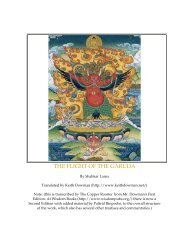Hiller - The Myth of Primitivism. Perspectives on Art - Esoteric Online
Hiller - The Myth of Primitivism. Perspectives on Art - Esoteric Online
Hiller - The Myth of Primitivism. Perspectives on Art - Esoteric Online
Create successful ePaper yourself
Turn your PDF publications into a flip-book with our unique Google optimized e-Paper software.
Locality fails 271<br />
15.2b Giorgio de Chirico: Temple in a<br />
Room (1927).<br />
In fact these ‘objects’ can be explained by more c<strong>on</strong>venti<strong>on</strong>al and immediate causes.<br />
After all they are not so surprising in themselves c<strong>on</strong>sidering the degree to which<br />
Australian experience is mediated by photography and photographic reproducti<strong>on</strong>. For<br />
these ‘objects’ which seem to be the members <str<strong>on</strong>g>of</str<strong>on</strong>g> an entirely new species <str<strong>on</strong>g>of</str<strong>on</strong>g> object are<br />
derived (mutated) from photographs though they are not photographs in themselves.<br />
While <str<strong>on</strong>g>of</str<strong>on</strong>g>ten resembling houses (master-built project homes) at other times they can<br />
resemble the Greek temples <str<strong>on</strong>g>of</str<strong>on</strong>g> de Chirico’s pictures. What is comm<strong>on</strong> to these ‘objects’<br />
is that some essential property seems to be missing. Collaged together from prefabricated<br />
comp<strong>on</strong>ents (<str<strong>on</strong>g>of</str<strong>on</strong>g>ten neo-classical in their reference) chosen from printed brochures, their<br />
visual attributes can be best described as ‘flatness’, ‘fr<strong>on</strong>tality’, ‘sharp focus’, ‘full<br />
colour’, ‘high resoluti<strong>on</strong>’, etc. In real life they evoke str<strong>on</strong>g feelings <str<strong>on</strong>g>of</str<strong>on</strong>g> déjà-vu and in the<br />
presence <str<strong>on</strong>g>of</str<strong>on</strong>g> other such ‘objects’ (e.g. in a street) they seem to partake <str<strong>on</strong>g>of</str<strong>on</strong>g> a game <str<strong>on</strong>g>of</str<strong>on</strong>g><br />
‘quotati<strong>on</strong>’ and ‘cross-reference’. <str<strong>on</strong>g>The</str<strong>on</strong>g>ir most plausible attribute is that <str<strong>on</strong>g>of</str<strong>on</strong>g> being<br />
‘photogenic’. Also since they are entirely derived from photographic representati<strong>on</strong>s they<br />
have the same qualities <str<strong>on</strong>g>of</str<strong>on</strong>g> surface, <str<strong>on</strong>g>of</str<strong>on</strong>g> reproducibility, and they acknowledge the same<br />
formal devices <str<strong>on</strong>g>of</str<strong>on</strong>g> framing and cropping as do photographs themselves. 18<br />
A c<strong>on</strong>venti<strong>on</strong>al and plausible explanati<strong>on</strong> (pre Bell’s theorem) <str<strong>on</strong>g>of</str<strong>on</strong>g> the resemblance<br />
between these ‘objects’ and the images in certain <str<strong>on</strong>g>of</str<strong>on</strong>g> de Chirico’s pictures would point to<br />
the fact that ‘simulati<strong>on</strong>’ (the quintessential quality <str<strong>on</strong>g>of</str<strong>on</strong>g> Australian life and culture and the<br />
means by which these ‘objects’ arise) is also an abiding interest <str<strong>on</strong>g>of</str<strong>on</strong>g> de Chirico—<br />
particularly in his later work. In these unfashi<strong>on</strong>able works, the melancholy <str<strong>on</strong>g>of</str<strong>on</strong>g> places (<str<strong>on</strong>g>of</str<strong>on</strong>g>




